Crouching Tiger, Hidden Dragon has an important legacy in the film world. It was a surprise international hit, made on a small-scale budget with beautiful stunts and fight choreography, enhanced by a heartrending plot and a group of incredible actors. It is easily one of the most important foreign language films in western cinema history because it proved that western audiences would not automatically shy away from subtitled movies, which had been Hollywood gospel at the time.
So when I say that Crouching Tiger, Hidden Dragon: Sword of Destiny fails to live up to its predecessor in nearly every respect, it is with a very heavy heart indeed.
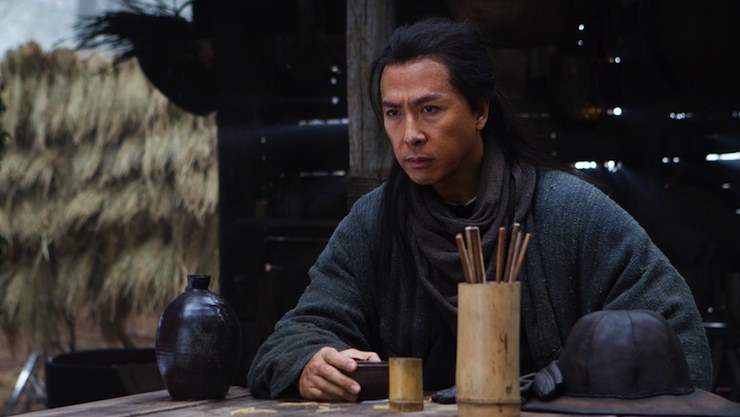
Directed by Yuen Woo-ping (who choreographed the fights for the first film), Sword of Destiny feels westernized in every sense of the word. For one, the film was shot in English. I gamely switched my Netflix over to Chinese with English subtitles, only to find that the actors’ mouths weren’t synching with the Mandarin dialogue. After the original film gained such respect with the subtitles intact, it seems painfully out of touch to simply film the whole sequel in English.
Then there’s location to consider. The first film was shot in China, but the sequel opted for the glorious backdrop of New Zealand. Problem is, nowhere in the world quite looks like New Zealand, and the country already sort of made its mark on the fantasy landscape by effectively becoming Middle-earth to the movie-going public. (The majority of their tourism is built on exactly that these days.) Before that, it was already pretty well-known for being ancient Greece in both the Xena and Hercules television shows. The scenery is recognizable enough to be distracting, and that’s without counting various other visual cues that only seem to play into it: for example, the villain’s evil tower HQ reads a lot like Isengard.
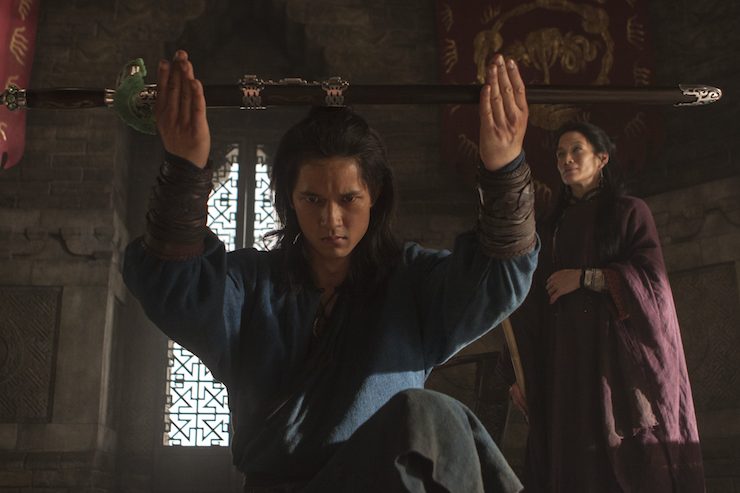
Crouching Tiger‘s trademark was the beautiful wirework stunts, making the characters seem to float on air from the ground to tree branches and rooftops alike. And while that unique wirework is still in play, it is also CGI half of the time as well. The change is too obvious when the wires aren’t being used, and it makes the film look less grounded, cheaper, and campier. Outside of that, the fight choreography is still gorgeous, but it’s a shame that these techniques couldn’t be reconciled into a more seamless film.
Also, there are a group of fighters in the film who literally read as Sif and the Warriors Three. I mean, exactly. There’s Thunder Fist, the sage one (Hogun); Turtle Ma, the drunken merry one (Volstagg); Flying Blade, the posh one who speaks in a British accent (Fandral); and Silver Dart Shi, the sole awesome lady (Sif). I understand that crews of fighting friends come with their own tropes, but when the Thor films are pretty current in the public consciousness, it might have been better to differentiate them a bit more thoughtfully.
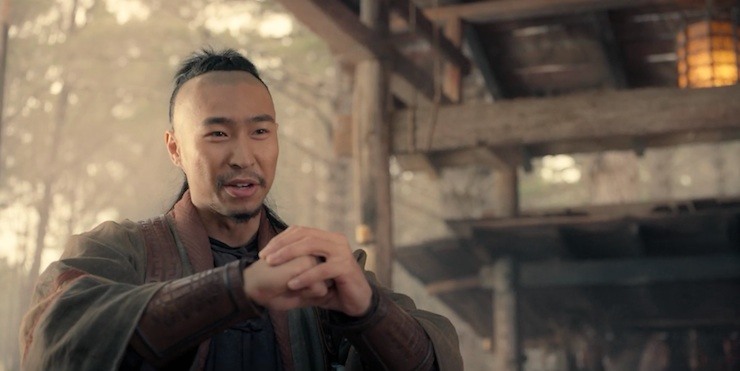
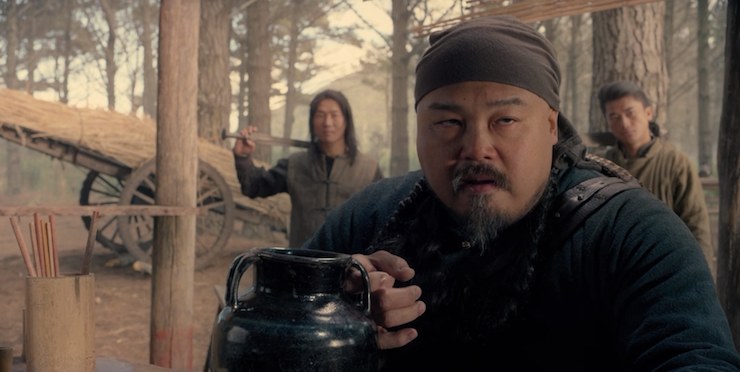

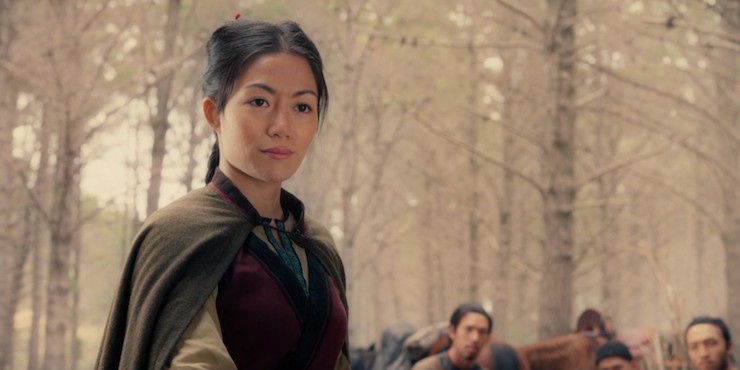
Honestly, there are too many disparate elements at work in this story. At its core, it is a continuation of the previous film, bringing the audience back into the tragic tale of Shu Lien and her lost love Li Mu Bai, and answering the question of what became of Lo and Jen Yu, following her potentially fatal jump off the side of a mountain. But there are so many other threads to pull, and far too many new characters to make sense of the thing. The story is sloppily paced and relies almost entirely on the action sequences to drive a fairly complicated plot. There are about seven characters who shouldn’t even be there, and could honestly be relegated to an entirely different movie.
And all of this is too bad because the remnants of a wonderful film are still present in Sword of Destiny. Michelle Yeoh is perfection as always, and continues to play Yu Shu Lien with deadly poise and wisdom. Her relationship with Snow Vase (Natasha Liu Bordizzo) over the course of this film shows gives more opportunity to explore the dynamic of a female mentor with a female apprentice, something that western films rarely give any screen time to at all, regardless of genre. In fact, the relationships of all the women in this film are fascinating, and if the script had been willing to carve away some of the more tedious character arcs to showcase those relationships, the movie might have been much more engaging.
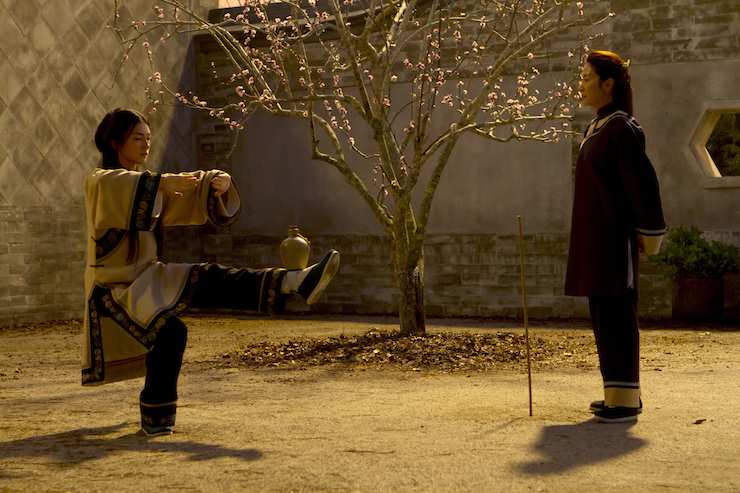
While Sword of Destiny was based on the final book in the Crane-Iron Series (Crouching Tiger was based on the penultimate book of the same series), the film comes off like an exercise from people who willfully forgot or ignored everything that made the first movie such a success. It was, at its heart, a personal story of love and loss, framed by elegant action. This film managed to muddy all of those aspects into a strange stew. And for Netflix to distribute this film while its busy trying to build its own brand is an awkward misstep to see them make. (Not that they haven’t made any others.) So if you want to be completist and watch this movie, enjoy, but put the first film out of your mind. They don’t mesh together, and a certain amount of cognitive dissonance might arise from trying to press these alternate universes together.
Or you could just watch Crouching Tiger, Hidden Dragon again. It’s a glorious today as it was sixteen years ago, like a perfectly aged wine.
Emmet Asher-Perrin was is also very curious about whether “Hades” is a name in Mandarin. Because if not, that villain name is ridiculous. You can bug her on Twitter and Tumblr, and read more of her work here and elsewhere.










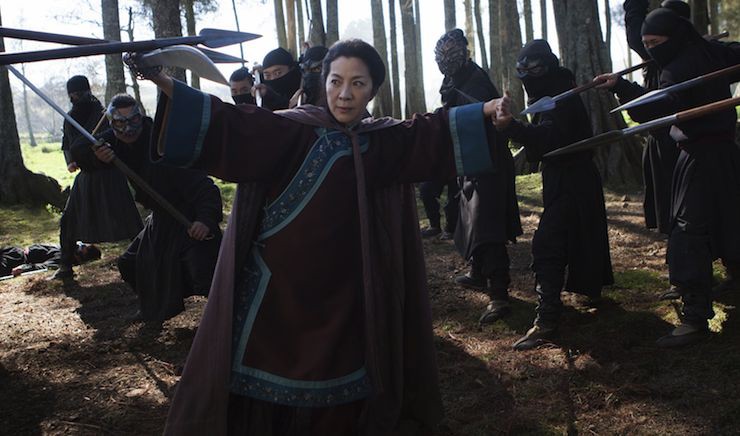
I think it looks awesome
Well, at least Michelle Yeoh is actually in it. I was bewildered by the recent “Christmas special” episode of Netflix’s Marco Polo, a half-hour flashback to the origins of the “Hundred Eyes” character, the blind warrior monk who became Marco’s mentor. Michelle Yeoh is prominently billed as a cast member, but she appears for maybe 15 seconds and contributes nothing to the story beyond calling the hero’s name and throwing one spear. That puzzled the heck out of me. My best guess is that she’s going to play a more sizeable role in season 2 and this was just a teaser to set it up.
I’d been planning to watch Sword of Destiny, but the reviews are making me reconsider.
How in hell has the Crane Iron series not had a translation yet. Is there a rights issue?
I thought it was a perfectly competent & watchable martial arts/wuxia movie (albeit a bit heavy on the CGI for my taste) that was crushed under the burden of being a sequel to Crouching Tiger, Hidden Dragon. But Michelle Yeoh was luminous as ever.
And I’d also love to see the novels translated into English.
Ok, now I’m not 100% sure because translations of this don’t exist and I’m not literate enough in Chinese to read these books outside of translation; but it’s fully possible your warriors three + Sif characters existed in the original novel. You know the one published in the early 1940s. The tropes you’re describing are COMMON for characters in wuxia novels. So maybe ease off on, “they’re just copying Marvel.”
Re: Translations, I haven’t exactly gone out of my way, but I have looked for translations of works by other wuxia authors, and there aren’t a lot out there. You’d be hard pressed to find translations of even the most popular wuxia novels, like the works of Louis Cha (aka Jin Yong), who (in my opinion) is to modern wuxia as JRR Tolkien is to modern fantasy. I’m under the impression (could be wrong) that most translations of classic wuxia novels, where they exist, are out of print, and I’m not sure if the Crane-Iron series have ever been translated at all. (Though I thought I saw a tie-in novel for Sword of Destiny somewhere.)
“the sage one, [ … ]the drunken merry one, [ and ] the posh one” — so basically the three musketeers. Anyone want to push that trope further back?
Also, there are a group of fighters in the film who literally read as Sif and the Warriors Three. I mean, exactly.
Not exactly. There are some parallels but these are basically about drawing from broad archetypes (and Silver Dart Shi, Thunder Fist et al don’t get enough screen time to be more than archetypes). So Ma is the kind-hearted comic relief who likes a drink, Thunder Fist is the big bruiser, and so on. (Volstagg, of course, occupies both these archetypes in the W3.) But Flying Blade is much more a leader of the group than Fandral ever is: Thunder Fist is nowhere near as grim or taciturn as Hogun: and there’s no similarity at all between Sif and Shi except that they’re both female.
I can see some basis for the comparison, but I feel you’re exaggerating it way beyond what’s actually on the screen.
My interpretation of the review wasn’t that the writer was complaining that they’d used the trope, nor were they suggesting that the Warriors Three were the first example of the trope.
The way I read that passage it was a complaint that the trope was executed *badly*, so badly that it (despite being a trope stretching back centuries) recalls the most memorable recent instance of it. Instead of being characters who share characteristics with their trope siblings, they are depicted as clones. The Musketeers are clearly different from the Warriors Three, but the reviewer is arguing that these guys guys aren’t..
@10/WillMayBeWise: Your comment got me curious about whether the Warriors Three (who don’t exist in Norse myth) were inspired by the Three Musketeers. Some sites suggest that they were. But it turns out that Stan Lee has said that he based Fandral on Errol Flynn, Volstagg on Shakespeare’s Falstaff, and Hogun on Charles Bronson.
I know there is an English comic book version of at least some of the Crane Iron series, because I own some.
Having watched the film, I have had problems with but not to the extent you have. I’d just like to offer up some kind of rebuttal for your first point, because I’ve seen this far too many times with this film.
Westerners complaining about the film being in English are, quite frankly, out of touch and boring. If you’d researched a little bit more, you’d have realized that the original film was somewhat of a flop in Mainland China because of the stars’ accents. None of the main characters were from the mainland, and with heavy Hong Kong and Malaysian Chinese accents when speaking Mandarin a lot of the original CTHD film was quite literally indecipherable to Chinese audiences. It did well internationally, but mostly to an audience who had no idea that the Mandarin was so god-awful.
All of the stars are much more comfortable in English than in Mandarin, something your piece fails to take into account. Harry Shum Jr is Korean, doesn’t speak Mandarin. Michelle Yeoh is Malaysian Chinese, and speaks English and Cantonese primarily.
Basically, people complaining that the second film isn’t in Mandarin don’t understand that even the original was largely rejected by Chinese audiences – i’m not saying it completely flopped, but it’s just another wuxia film. If you think the “magic” of the first one is lost when the language changes, you might want to check yourself because it sounds a lot like you’re fetishizing Mandarin.
Apologies, I mean Chinese-American, not Korean when I spoke about Harry Shum Jr. Regardless, he doesn’t speak Mandarin fluently and is more comfortable in English and Cantonese.
@12 I have them too though IIRC they’re translations of a manhua published in Taiwan? It was awhile ago and mine are buried in storage, so I don’t recall if they covered the Green Destiny or not (or even if the series finished, I think I have only three).
@13 and to add to this point, at the time of the original film, Michelle Yeoh was pretty upfront about how difficult she found it to perform in a language she had to memorize syllable by syllable. I don’t know for a fact, but it certainly wouldn’t surprise me to find out she made it a condition of her doing the sequel for it to not be in Mandarin.
Count me among those who enjoyed the film, as a wuxia film. But I did pretty much ignore any connection to CT, HD.
Taken as a stand-alone, the film has flaws (as the reviewer notes, there are superfluous characters and the pieces don’t fit together all that well) but delivers some good moments. The relationships between Shu Lien and Snow Vase, on the one hand, and Silent Wolf, on the other, provide a satisfying backdrop for the more conventional set pieces.
I can see why someone wanting it to live up to the standard of CT, HD would be disappointed. But it’s not a terrible film.
the first crouching tiger SUCKS when you watch it in english… but i didn’t know the mandarin wasn’t good so… idk… did i miss what became of Lo and Jen Yu???? i don’t remember from this one… and yeah it was not great but… it was watchable…
crouching tiger hidden dragon is like one of the best films ever made though so… then theres that…
the shot of the fisherman throwing the net in the water is one of the most incredibly beautiful things i have ever seen…